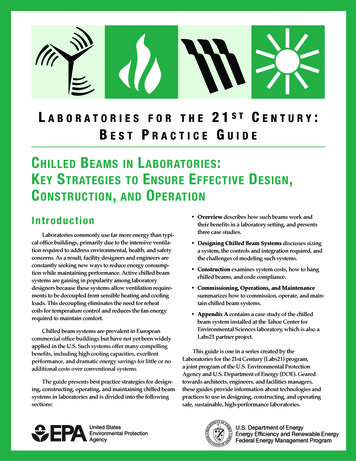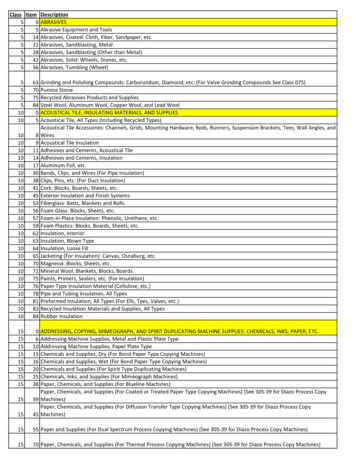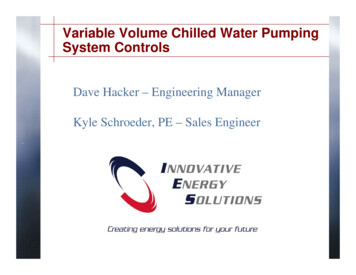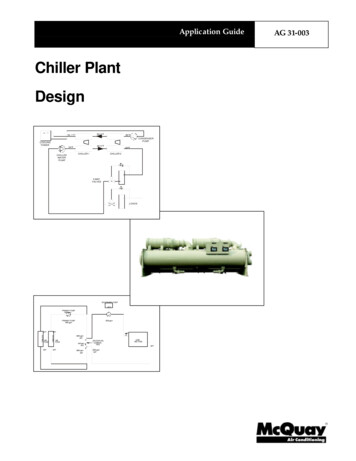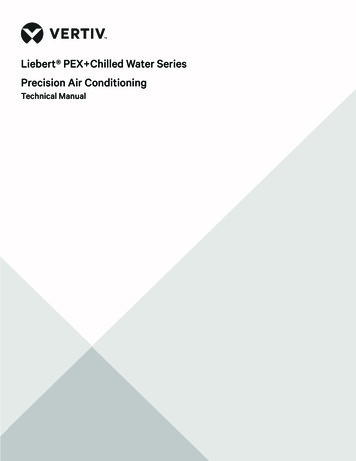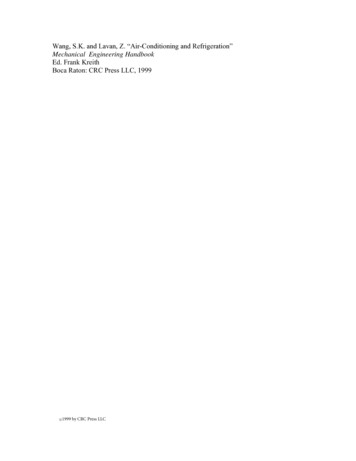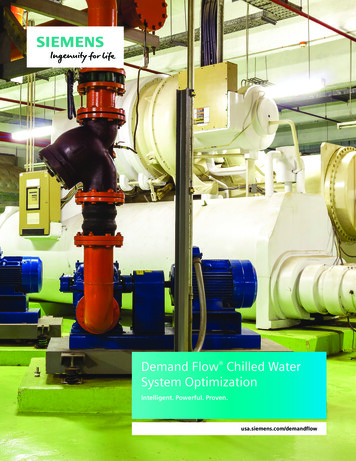
Transcription
Demand Flow Chilled WaterSystem OptimizationIntelligent. Powerful. Proven.usa.siemens.com/demandflow
Demand Flow CHW Smart InfrastructureA powerful solution to reduce energyconsumption and improve operations.Siemens Demand Flow Chilled Water System Optimization offering is a unique,patented, and proven optimization strategy that reduces energy consumption,improves occupant comfort, and extends equipment life. To achieve maximumenergy savings, Demand Flow CHW from Siemens employs variable speedpumping on the chilled water and condenser water pumps, and operates variablespeed cooling tower fans, without the need for expensive chiller drive options.2
Smart Infrastructure Demand Flow CHWThe Demand Flow CHW offering provides significant energysavings in water-cooled centrifugal or screw type chilled watersystems—typically 20-50% energy use reduction with measuredtotal chilled water system performance as low as 0.33 kW/ton.Demand Flow CHW is chiller brand agnostic and can beimplemented on any existing building automation system.Demand Flow CHW: Offers a holistic approach for optimizing the entire chilledwater system, including potential air-side savings Does not shift energy from one sub-system to another,but reduces overall total system energy consumptionTypical Operational Shortcomings in Chilled Water SystemsAcross the US, Siemens has found many chilled water systemsthat are plagued with shortcomings, which cause: Diminished deliverable tonnage due to:– Low Delta-T Syndrome, which contributes to a perceivedneed for more equipment– Chilled Water Reset, when chilled water temperatureis raised it can reduce cooling coil capacity Excessive energy consumption due to:– Excessive chiller lift Often increases the deliverable tonnage of the chilled watersystem, allowing for more effective cooling withless equipment, thus increasing system redundancy– Bypass of chilled water flow Does not sacrifice comfort or process cooling efficacy toobtain the energy savings– Untuned chilled water control system components Simplifies system control methodology for more intuitiveoperation of plant equipment Potentially extends equipment life through less wear andtear on the equipmentSiemens Demand Flow CHW measures and verifies eachsub-system’s energy consumption as part of the total energyusage. Siemens often finds the opportunity to deliver colderchilled water to the coils while providing significant energysavings. This colder deliverable chilled water is especiallybeneficial in potentially reducing air-handling fan energyin VAV systems.– Constant volume pumping– Non-optimized cooling towers– Inefficient and overly complex sequencing Diminished occupant comfort or ineffective processcooling, which can lead to reduced employee productivityor reduced profitability Decreased equipment life Inability to measure and maintain sub-system performanceThe Chiller Plant Efficiency SpectrumDemand Flow CHWHigh-efficiencyOptimizedChiller ionalCode BasedChiller PlantsGOOD0.7(5.0)0.8(4.4)Older ChillerPlantsFAIR0.9(3.9)Chiller Plants withCorrectable Design orOperational ProblemsNEEDS IMPROVEMENT1.0(3.5)1.1(3.2)1.2(2.9)Average annual chiller plant efficiency in kW/Ton (C.O.P.)(Input energy includes chillers, condenser pumps, chilled water distribution pumps and tower fans)Source: “All Variable Speed Chiller Plants,” ASHRAE Journal, September 20013
Demand Flow CHW Smart InfrastructureImpact of Demand Flow on Total System kWUp to a50%Reductionin totalsystemenergyusageChillersCHW PumpsCW PumpsCoolingTowersAHU FansTotal System kWBefore Demand Flow CHWImplementationMany facilities are limited to how cold they can drive theirtower water supply temperature in low wet-bulb conditions.This limits the ability to minimize lift in the chiller and reducechiller energy. Demand Flow CHW takes a holistic approachto optimize the entire chilled water system (Chillers, CHWPumps, CW Pumps, CT Fans, AHU) in real-time relative to load,without having to rely on variable speed chillers to maintainthe required minimum lift.4After Demand Flow CHWImplementationkWUncompromised Performance for Improved OperationsDemand Flow CHW delivers improved energy efficiencyand operational improvements throughout your facility,including: Improved Occupant Comfort: Demand Flow CHWoptimization solves “Low Delta-T Syndrome” andpotentially allows your system to deliver colder chilledwater year-round. With Demand Flow CHW, your building’shumidity and temperature levels can be more effectivelycontrolled, creating a more productive, comfortable indoorenvironment. The energy savings, coupled with improvedenvironmental quality, easily contribute to achieving mostorganizations’ potential energy and sustainability goalsand objectives.
Smart Infrastructure Demand Flow CHWSiemens Navigator Cloud-Based Energy ReportingDemand Flow Plant Performance (in 0450500550600650700750800850Chiller Output [tons]Base Plant EfficiencyPredicted Plant EfficiencyActual Plant EfficiencyTotal water system component performance can be measured via Siemens Navigator E xtended equipment life: Demand Flow CHW’s patented“Variable Pressure Curve Logic” Technology empowersthe conversion of constant speed condenser pumpsand chilled water pumps to variable speed throughthe installation of Variable Frequency Drives (VFDs).The Demand Flow CHW algorithms enable the VFDs tomaintain optimal system differential pressure, reduceequipment runtime, and increase system deliverabletonnage—all of which combine to reduce maintenancerequirements and extend the life of your equipment. I ntuitive Reporting: Demand Flow CHW measures eachchilled water system component either through kW outputson the VFDs or through the installation of Digital EnergyMonitors. This sub-metered data is organized and viewablevia the internet through Siemens Navigator cloud-basedplatform. Navigator enables better management ofongoing operations to meet energy reduction andsustainability goals. Simplified chilled water system operations: Demand FlowCHW automatically optimizes and automates all plantfunctions and is accessible through a unique GraphicalUser Interface (GUI). Sequencing of equipment becomesmuch simpler, thanks to optimal operation of all plantequipment at any given load, which enables simplelead/lag equipment sequencing based on run-hours.5
Demand Flow CHW Smart InfrastructureApplying Siemens Technology and ExpertiseDemand Flow CHW technology has been proven successfulin more than 650 installations across the globe. From hotels,manufacturing, and commercial office spaces to hospitals,universities, pharmaceuticals, and data centers, Siemens hasbeen able to deliver reduced energy consumption, improvedoccupant comfort, simplified chilled water system operations,and extended equipment life by applying the Demand FlowCHW strategy.To support our growing list of Demand Flow CHW customers,Siemens has created the Demand Flow Center of Excellenceteam. This team of subject matter experts support our morethan 600 trained professionals, including energy engineersand sales professionals, located in our more than 125 localbranch offices across the US and Canada.What Siemens has Learned6Common System CharacteristicsInherent ShortcomingsDemand Flow CHW SolutionOperate at design intent conditions only5% of the time (per ARI standards)Inefficient and costly plant operations95% of the time (per ARI standards)Demand Flow CHW puts the entire systemin its most efficient state year-round,regardless of loadComfort is often sacrificed to obtainefficiency, or efficiency is sacrificed to obtaincomfort requirementsUncomfortable occupants – reducedproductivity or utility bill riseDemand Flow CHW does not sacrificecomfort to achieve energy savings; ourcustomers do not have to compromiseChillers not operating at designtemperature splitsPlagued with “Low Delta-T Syndrome”Solves Low Delta-T Syndrome and increasessystem deliverable tonnageContinuous full speed operation of someplant equipmentDecreased equipment lifeLess wear and tear and reduced run-time –improved equipment life and lessenergy usage
Published bySiemens Industry, Inc. 2021Building Technologies Division1000 Deerfield ParkwayBuffalo Grove, IL 60089Tel: (847) 215-1000Part # 153-BPS-884 (01/2021)Subject to changes and errors. The information given inthis document only contains general descriptions and/orperformance features which may not always specificallyreflect those described, or which may undergo modificationin the course of further development of the products.The requested performance features are binding only whenthey are expressly agreed upon in the concluded contract. Siemens Industry, Inc., 2021
systems—typically 20-50% energy use reduction with measured total chilled water system performance as low as 0.33 kW/ton. Demand Flow CHW is chiller brand agnostic and can be implemented on any existing building automation system. Demand Flow CHW: Offers a holistic approach for optimizing the entire chilled


